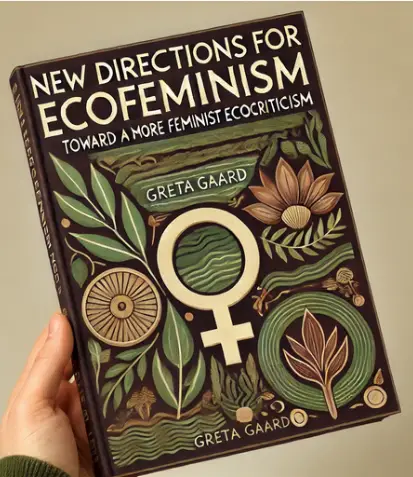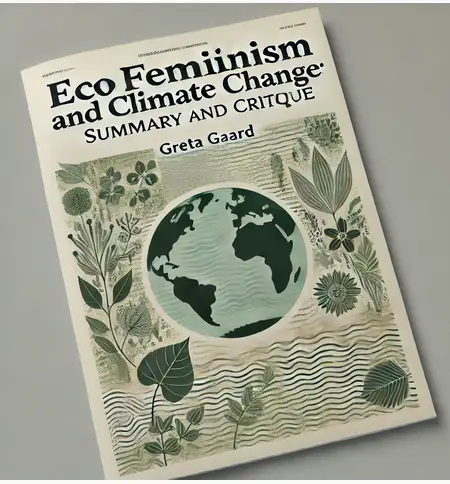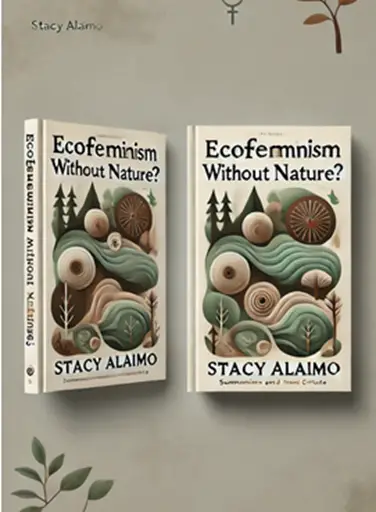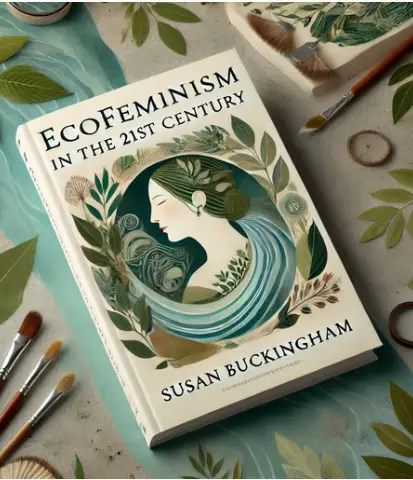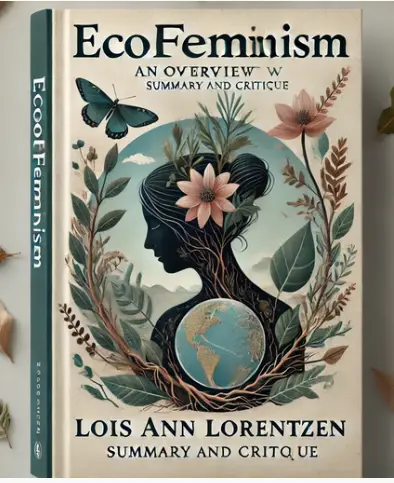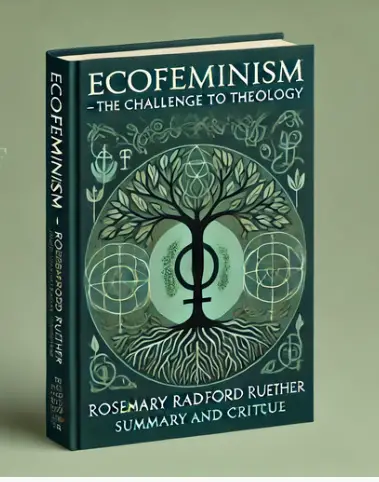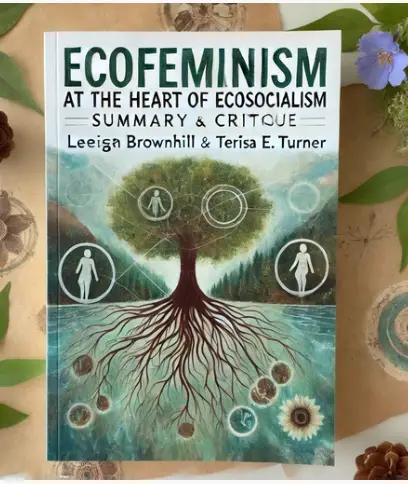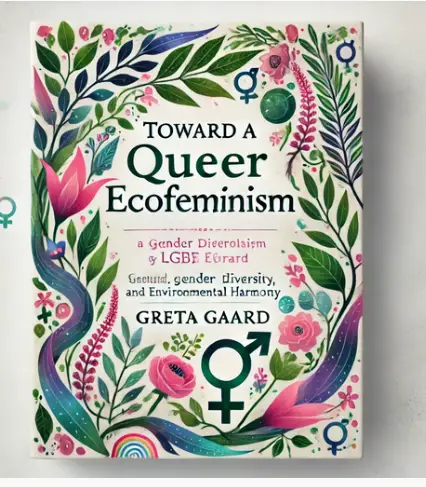
Introduction: “Toward A Queer Ecofeminism” By Greta Gaard
“Toward a Queer Ecofeminism” by Greta Gaard was first published in 1997 in the journal Hypatia, Volume 12, Issue 1, on page 137. This seminal article investigates the intersections of ecofeminism and queer theory, aiming to bridge a significant gap by systematically examining how heterosexism, colonialism, and Christianity have constructed and sustained oppressive frameworks around “the natural.” Gaard argues that ecofeminism, rooted in dismantling the interlocking systems of oppression across race, class, gender, and species, must expand to include queer theory to address the diverse, lived experiences of individuals who challenge these hegemonic norms. Central to Gaard’s argument is the concept of dualisms, such as culture/nature and heterosexual/queer, which underpin Western patriarchal thinking and perpetuate hierarchies that alienate and devalue both the natural world and those who embody or embrace diverse sexualities. Gaard contends that these dualisms must be broken down for genuine liberation, advocating for a coalition-based approach that integrates sexual and ecological diversity into ecofeminist activism. In literary theory and feminist discourse, this work holds significant importance as it expands the scope of ecofeminist thought, offering an inclusive and intersectional perspective that paves the way for a more democratic and ecological society valuing all forms of life and identity.
Summary of “Toward A Queer Ecofeminism” By Greta Gaard
- Introduction to Queer Ecofeminism and Intersectional Theory
Gaard highlights a lack of comprehensive examination of the intersection between ecofeminism and queer theory, arguing that both frameworks could mutually enhance each other. She asserts, “Although many ecofeminists acknowledge heterosexism as a problem, a systematic exploration of the potential intersections of ecofeminist and queer theories has yet to be made.” By examining social constructs around “naturalness” and the logic of domination, Gaard emphasizes the need to include queer perspectives in ecofeminism to foster a holistic approach to liberation (Gaard, 1997). - Coalition-Building on the Left
A core message is Gaard’s critique of disunity among progressive movements. She notes how differing groups often operate in isolation, even as conservative groups unite against their collective causes. She argues, “The future of progressive organizing may well depend on how effectively scholars and activists can recognize and articulate our many bases for coalition.” She points to ecofeminism as a model of coalition-building, as it connects environmental, feminist, civil rights, and animal rights issues into a broader framework of liberation (Gaard, 1997). - Ecofeminism’s Analysis of Dualisms and Oppression
Gaard addresses ecofeminism’s foundational critique of oppressive dualisms—like culture/nature, male/female, reason/emotion—that structure Western thought. According to ecofeminism, these dualisms uphold a “master identity” by alienating and subordinating the “other,” linking the oppression of women, non-white people, animals, and nature. She writes, “The master identity… creates and depends on a ‘dualized structure of otherness and negation,’” asserting that dismantling these structures is essential to liberation (Gaard, 1997). - Importance of Queering Ecofeminism
Gaard explains that ecofeminism must embrace queer theory to be genuinely inclusive, acknowledging that oppression based on sexuality is deeply rooted in societal structures that devalue both nature and non-heteronormative identities. She states, “To be truly inclusive, any theory of ecofeminism must take into consideration the findings of queer theory,” underscoring the need for ecofeminism to evolve by examining heteronormative biases (Gaard, 1997). - Challenging “Natural” and “Unnatural” Sexualities
The article critiques Western constructions that label queer sexualities as “unnatural.” Gaard argues that this stigmatization echoes how Western thought devalues nature itself. She explains, “The charge that queer sexualities are ‘against nature’… implies that nature is valued—yet ecofeminists have shown that, in Western culture, this is not the case.” This inconsistency highlights the contradiction inherent in dominant ideological structures (Gaard, 1997). - Ecofeminist Critique of Erotophobia and Compulsory Heterosexuality
Gaard addresses Western culture’s rejection of the erotic and non-heteronormative sexuality as part of broader colonialist and religious traditions. She examines “how Christianity has been used to authorize the exploitation of women, indigenous cultures, animals, the natural world, and queers,” explaining that ecofeminism and queer theory share roots in resisting erotophobic and oppressive systems (Gaard, 1997). - Conclusion: Toward a Liberatory Ecofeminism
Gaard advocates for a queer ecofeminist framework that challenges all forms of oppression. She concludes, “Ecofeminists must be concerned with queer liberation, just as queers must be concerned with the liberation of women and of nature; our parallel oppressions have stemmed from our perceived associations.” This perspective calls for coalition-based activism to foster an inclusive ecological society that values both natural and sexual diversity (Gaard, 1997).
Literary Terms/Concepts in “Toward A Queer Ecofeminism” By Greta Gaard
| Literary Term/Concept | Explanation |
| Dualism | The idea of binary oppositions (e.g., culture/nature, male/female) that structure Western thought, creating hierarchies where one term dominates the other. Gaard critiques these as reinforcing structures of oppression. |
| Master Identity | Val Plumwood’s concept of a dominant identity in Western culture, defined by its separation from and control over nature, women, and marginalized groups. Gaard uses this to explain ecofeminism’s critique of hierarchical social structures. |
| Erotophobia | A fear or aversion to the erotic, prevalent in Western culture. Gaard argues that erotophobia underpins many oppressive structures, including heteronormativity and the devaluation of queer and non-reproductive sexualities. |
| Compulsory Heterosexuality | A term coined by Adrienne Rich, describing how heterosexuality is enforced as the normative and “natural” sexuality. Gaard applies this to ecofeminism, arguing that queer identities are marginalized within dominant frameworks of sexuality. |
| Intersectionality | The interconnected nature of social categorizations like race, gender, and sexuality, which Gaard suggests are vital for understanding the layered forms of oppression addressed by a queer ecofeminism. |
| Coalition-Building | The practice of forming alliances across different social movements (e.g., environmental, feminist, LGBTQ+). Gaard sees coalition-building as essential for a progressive movement against intersecting oppressions. |
| Heterosexism | The assumption that heterosexuality is superior or the default sexuality. Gaard critiques ecofeminism for often ignoring this, calling for a queer ecofeminism that incorporates an analysis of heterosexist biases. |
| Queer Theory | An academic field that challenges normative assumptions about gender and sexuality, advocating for the inclusion of marginalized sexual identities. Gaard suggests that ecofeminism and queer theory can mutually enhance each other. |
| Social Construction of Nature | The idea that concepts of “natural” are socially constructed, often to reinforce dominant ideologies. Gaard critiques the ways Western culture has used “nature” to marginalize queer identities as “unnatural.” |
| Colonialism | The practice of domination over foreign lands and peoples, which Gaard links to heterosexism and ecofeminism. She argues that colonial frameworks historically exploited both women and queer people, often through religious justification. |
| Logic of Domination | A concept in ecofeminism that describes how hierarchical thinking legitimizes the subjugation of others (e.g., humans over nature, men over women). Gaard applies this to argue for queer inclusion in ecofeminist critique. |
| Ecofeminism | A movement that links the exploitation of nature with the oppression of women, arguing that liberation of one is tied to the other. Gaard extends this to include queer identities, suggesting a “queer ecofeminism” to expand the theory. |
| Value Hierarchical Thinking | The practice of assigning higher value to one group over another, often used to justify domination. Gaard critiques this in dualisms where traits associated with men or humans are valued over those linked to women or nature. |
| Queer Ecofeminism | Gaard’s proposal to combine queer theory and ecofeminism, arguing that an inclusive ecofeminism should address heterosexism and acknowledge the interconnectedness of ecological and queer liberation. |
| Epistemology of the Closet | Eve Sedgwick’s concept describing how normative binary structures shape sexual identity. Gaard references this to highlight how dualistic thinking marginalizes queer identities and aligns with ecofeminist critiques of binary hierarchies. |
Contribution of “Toward A Queer Ecofeminism” By Greta Gaard to Literary Theory/Theories
- Ecofeminism
Gaard’s work is foundational in expanding ecofeminism to include queer perspectives. By linking environmental degradation with gender and sexual oppression, she argues that ecofeminism must “take into consideration the findings of queer theory” to be fully inclusive (Gaard, 1997). This interdisciplinary approach pushes ecofeminism beyond its traditional scope by challenging heteronormativity, thus enriching ecofeminist critiques of “mutually reinforcing” systems of oppression that impact both women and nature. - Queer Theory
“Toward A Queer Ecofeminism” extends queer theory by aligning it with environmental and feminist issues. Gaard advocates for a coalition-based activism, stating that “the future of progressive organizing may well depend on how effectively scholars and activists can recognize and articulate our many bases for coalition” (Gaard, 1997). She challenges queer theory to consider ecological and ecofeminist insights, thus advancing queer theory’s examination of the “natural” versus “unnatural” binary imposed by Western culture. - Postcolonial Theory
Gaard’s analysis contributes to postcolonial theory by showing how Western dualistic thinking supports both environmental exploitation and the colonial subjugation of marginalized groups, including indigenous people and queer identities. She connects ecofeminism with postcolonial critique, exploring how colonial frameworks have historically justified “the exploitation of women, indigenous cultures, animals, the natural world, and queers” through the rhetoric of Christianity and other dominant ideologies (Gaard, 1997). - Critical Theory and Intersectionality
By addressing the intersections between race, gender, sexuality, and ecological concerns, Gaard’s work aligns with critical theory and intersectionality. She discusses how ecofeminism draws on “the socialist feminist insight that racism, classism, and sexism are interconnected” to reveal that systems of oppression are inextricably linked (Gaard, 1997). This intersectional approach urges critical theorists to consider ecological perspectives in their analysis of power dynamics and social structures. - Gender and Sexuality Studies
Gaard’s critique of compulsory heterosexuality and erotophobia as forces that alienate queer identities from ecofeminist discussions contributes significantly to gender and sexuality studies. She argues, “Western culture’s rejection of the erotic parallels its devaluations of women and of nature,” highlighting the importance of embracing queer sexualities within ecofeminist frameworks to dismantle oppressive binaries like heterosexual/queer (Gaard, 1997). This work integrates queer and feminist thought to enrich the study of gender and sexuality within literature and theory. - Social Constructivism
The article also bolsters social constructivism by examining how Western society’s definitions of “natural” and “unnatural” are socially constructed to enforce heteronormativity and ecological exploitation. Gaard’s critique reveals that “the charge that queer sexualities are ‘against nature’ implies that nature is valued,” yet ecofeminist critiques show that nature is devalued in Western society, uncovering the contradictions in dominant ideological structures (Gaard, 1997). This emphasis on constructed norms challenges readers to reevaluate naturalized views of sexuality and the environment.
Examples of Critiques Through “Toward A Queer Ecofeminism” By Greta Gaard
| Literary Work | Potential Critique Using Gaard’s “Toward A Queer Ecofeminism” |
| “The Tempest” by William Shakespeare | Using Gaard’s ecofeminist perspective, one could critique The Tempest by examining the dualism of culture/nature. Prospero’s control over the island and its inhabitants, especially Caliban, mirrors Western colonial and patriarchal domination. Gaard’s work highlights how this domination relies on “the logic of domination” that alienates nature, women, and the marginalized. |
| “Frankenstein” by Mary Shelley | Frankenstein could be critiqued by exploring how Gaard’s concept of dualisms (e.g., mind/body, nature/science) applies to Victor Frankenstein’s attempt to dominate nature through science. This reflects Western erotophobia and ecofeminist concerns, where Victor’s obsession with “reason” over “nature” reinforces alienation from both queer identity and the natural world. |
| “Beloved” by Toni Morrison | Gaard’s framework would analyze Beloved through the lens of ecofeminism and intersectionality, especially in how racial, sexual, and ecological oppression intersect. Sethe’s trauma and reclaiming of agency reflect how oppressions are “mutually reinforcing,” and Gaard’s work offers insight into how liberation from one form of oppression impacts all forms. |
| “Orlando” by Virginia Woolf | Using Gaard’s queer ecofeminism, one could critique Orlando for its challenge to heteronormative and patriarchal views on gender and nature. Woolf’s fluid portrayal of Orlando’s gender aligns with Gaard’s call for “queers to come out of the woods and speak for ourselves,” deconstructing the heterosexual/queer and culture/nature binaries. |
Criticism Against “Toward A Queer Ecofeminism” By Greta Gaard
- Overgeneralization of Western Dualisms
Gaard’s critique may overly generalize Western culture as entirely dualistic, potentially overlooking nuances within Western philosophical traditions that challenge or critique these binaries. - Lack of Practical Application
While Gaard outlines theoretical intersections, critics may argue that the essay lacks specific, practical pathways for applying queer ecofeminism within activism or policy-making, leaving its influence more conceptual than actionable. - Limited Engagement with Non-Western Perspectives
Gaard’s analysis primarily critiques Western ideologies but does not deeply engage with non-Western or Indigenous perspectives, which could broaden ecofeminist and queer theory through alternative frameworks on nature, gender, and sexuality. - Potential for Essentialism in Queer and Feminist Identities
Some critics may argue that Gaard’s combination of ecofeminism and queer theory risks essentializing queer identities, as it sometimes implies a universal queer or feminist experience of oppression that may not account for the diversity within these communities. - Ambiguity in Queer and Ecofeminist Coalition
Gaard calls for coalition-building but does not fully address the complexities and challenges of creating alliances across ecofeminist and queer movements, which can have divergent priorities or goals. - Focus on Theory over Empirical Evidence
Critics might note that Gaard’s work is heavily theoretical, with limited empirical evidence or case studies to support the real-world applicability of a queer ecofeminist framework.
Representative Quotations from “Toward A Queer Ecofeminism” By Greta Gaard with Explanation
| Quotation | Explanation |
| “Although many ecofeminists acknowledge heterosexism as a problem, a systematic exploration of the potential intersections of ecofeminist and queer theories has yet to be made” (Gaard 137). | Gaard points to a critical gap in ecofeminist literature and highlights the need for integrating queer theory, which addresses heteronormative structures that reinforce oppression. |
| “The future of progressive organizing may well depend on how effectively scholars and activists can recognize and articulate our many bases for coalition” (Gaard 137). | Emphasizing coalition-building, Gaard suggests that bridging queer and ecofeminist perspectives could unify efforts across social justice movements against intersecting forms of oppression. |
| “The master identity… creates and depends on a ‘dualized structure of otherness and negation’” (Gaard 137). | Here, Gaard critiques Western ideologies that enforce hierarchical, binary thinking, identifying how these concepts uphold systems of domination that ecofeminism and queer theory both aim to dismantle. |
| “It is not enough simply to add ‘heterosexism’ to the long list of dominations that shape our relations to nature, to pretend that we can just ‘add queers and stir’” (Gaard 137). | Gaard criticizes superficial approaches to inclusivity, advocating for a more profound integration of queer theory into ecofeminist thought rather than tokenistic gestures. |
| “To be truly inclusive, any theory of ecofeminism must take into consideration the findings of queer theory” (Gaard 137). | Gaard argues that ecofeminist theory must encompass queer perspectives to authentically address interlinked structures of environmental and social domination. |
| “Dominant Western culture’s devaluation of the erotic parallels its devaluations of women and of nature; in effect, these devaluations are mutually reinforcing” (Gaard 137). | She connects ecofeminist critiques with queer theory by showing how Western culture’s suppression of the erotic supports both environmental degradation and the oppression of women and queer people. |
| “Ecofeminism is rooted in the understanding that the many systems of oppression are mutually reinforcing” (Gaard 137). | Gaard underlines ecofeminism’s foundational belief that forms of oppression are interdependent, a stance that supports her call for incorporating queer perspectives into ecofeminist frameworks. |
| “The conceptual connections among the oppressions of women, nature, and queers make this need particularly clear” (Gaard 137). | This statement encapsulates Gaard’s argument that ecological, gender-based, and queer oppressions share roots in Western dualisms, making a queer ecofeminist approach essential for comprehensive critique. |
| “Queers are feminized, animalized, eroticized, and naturalized in a culture that devalues women, animals, nature, and sexuality” (Gaard 137). | Gaard critiques Western constructs that use negative associations with nature, femininity, and animality to marginalize queer identities, highlighting how this reinforces the need for a queer ecofeminist critique. |
| “We must combine the insights of queer and ecofeminist theories” (Gaard 137). | The essay’s call to action, emphasizing that the path to an inclusive ecological and social justice movement requires a synthesis of queer and ecofeminist insights. |
Suggested Readings: “Toward A Queer Ecofeminism” By Greta Gaard
- Gaard, Greta. “New Directions for Ecofeminism: Toward a More Feminist Ecocriticism.” Interdisciplinary Studies in Literature and Environment, vol. 17, no. 4, 2010, pp. 643–65. JSTOR, http://www.jstor.org/stable/44087661. Accessed 29 Oct. 2024.
- Lee, Wendy Lynne, and Laura M. Dow. “Queering Ecological Feminism: Erotophobia, Commodification, Art, and Lesbian Identity.” Ethics and the Environment, vol. 6, no. 2, 2001, pp. 1–21. JSTOR, http://www.jstor.org/stable/40339010. Accessed 29 Oct. 2024.
- DECKHA, MANEESHA. “Toward a Postcolonial, Posthumanist Feminist Theory: Centralizing Race and Culture in Feminist Work on Nonhuman Animals.” Hypatia, vol. 27, no. 3, 2012, pp. 527–45. JSTOR, http://www.jstor.org/stable/23254839. Accessed 29 Oct. 2024.
- Kearns, Sofía. “Widening the Spectrum of Desire and Nation: Anacristina Rossi’s Fiction.” QED: A Journal in GLBTQ Worldmaking, vol. 3, no. 2, 2016, pp. 93–106. JSTOR, https://doi.org/10.14321/qed.3.2.0093. Accessed 29 Oct. 2024.
- Anderson, Jill E. “‘The Element That Shaped Me, That I Shape by Being In’: Alternative Natures in Margaret Atwood’s Surfacing and The Edible Woman.” This Book Is an Action: Feminist Print Culture and Activist Aesthetics, edited by Jaime Harker and Cecilia Konchar Farr, University of Illinois Press, 2016, pp. 113–29. JSTOR, http://www.jstor.org/stable/10.5406/j.ctt17t75xc.9. Accessed 29 Oct. 2024.
